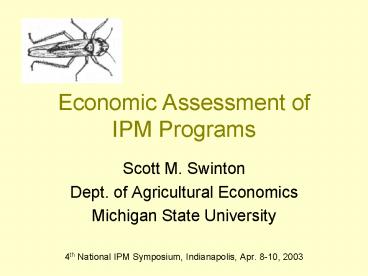Economic Assessment of IPM Programs - PowerPoint PPT Presentation
1 / 20
Title:
Economic Assessment of IPM Programs
Description:
Outcomes may be monetary or not. Adoption per se is not an outcome; it ... Market-adjusted net benefits per adopter. Environmental & health benefits. Valuation ... – PowerPoint PPT presentation
Number of Views:56
Avg rating:3.0/5.0
Title: Economic Assessment of IPM Programs
1
Economic Assessment of IPM Programs
- Scott M. Swinton
- Dept. of Agricultural Economics
- Michigan State University
- 4th National IPM Symposium, Indianapolis, Apr.
8-10, 2003
2
Purpose
- Economic assessments aim to evaluate the net
benefits of investments in IPM - Focus on valued outcomes
- Outcomes may be monetary or not
- Adoption per se is not an outcome it is an
intermediate step that affects outcomes - Scale
- Individual
- Society
3
User-level profitability assessment
- Partial budget or partial enterprise budgets
- Does average change in benefits from IPM exceed
average change in costs? - Capital budget (investment analysis)
- Does investment in IPM over time generate
benefits that cover costs? - Risk analysis
- Does adoption of IPM cause change in probability
distribution of net returns?
4
Illustrative partial budget Intermediate IPM
replaces Conventional PM in 10-ac tart cherry
orchard, 1998
Source M. Williams M.S., 2000
5
Potential discounted cumulative returns to
investment in IPM
Cumulative Net gain
Discounted Cumulative Net gain _at_ 10
Discounted Annual Net gain _at_ 10
1
2
3
4
5
6
7
8
9
Year
Discounted Break-even In Year 9-10
Break-even In Year 7
6
Adding risk and environmental benefits to a
profit analysis
- Assign cash values factor into money measure
- Use non-money measures evaluate trade-offs
(multi-criteria analysis) - Mean profit vs. Variance
- Profit vs. pesticide exposure
7
Mean-risk profitability tradeoff in tart cherry
groundcover management (NW Mich, 1995-2000)
x
x
Desired direction
8
Profitability-nitrate leaching tradeoff in tart
cherry groundcover systems (NW Mich, 1995-2000)
x
Desired direction
9
Reduction in Cost and Environ. Impact by IPM
Level Michigan Tart Cherry, 1999
Intermediate IPM
Basic IPM
Advanced IPM
Conventional
10
Challenges to incorporate environment health in
economic analysis
- Cost-effective non-market valuation
- Environmental economists have developed a variety
of methods, but most require costly, targeted
studies - Emergent lit on benefit transfer from prior
studies - How to aggregate different EH benefits?
- Scoring measures
- Subjectivity problem
- Scores not necessarily designed for assessment
- Multiple EH measures
- Unwieldy to analyze
- Diminishing willingness to pay for more EH
benefits
11
Scaling up from one IPM user to society Adoption
- Need clear, simple IPM definition to measure
adoption - Projecting adoption trends into the future
100
Max adoption
Percent adoption
0
Time
Present
12
Scaling up from one IPM user to society Market
effects
- When many users adopt IPM, indirect market
effects may result - Price effect (supply curve shifts)
- Higher yields will depress price
- Higher costs will cause some producers to exit,
increasing prices for those who remain - Income effect (input demand shifts)
- Higher producer incomes may raise demand for
environmentally friendly inputs - Economic surplus analysis can estimate effects
13
If IPM raises yields, shifting Supply from S to
S
S
Price
S
CS
p
PS
D
Q
Quantity
14
Current state of the art
- Benefit-cost analysis over time based on
- Adoption trends
- IPM public program costs
- Market-adjusted net benefits per adopter
- Environmental health benefits
- Valuation
- Trade-offs
- Staff paper on Economics of IPM
- http//agecon.lib.umn.edu/cgi-bin/pdf_view.pl?pape
rid1854
15
Challenges aheadCost-effective assessments
- Excellent impact assessments are costly
- Expert opinion is cheap can lead to error bias
- Surveys are costly, but cooperation with NASS can
cut costs strengthen data quality - Benefit transfer research is developing new tools
for adapting prior EH valuation results to new
settings - Scaling up economic assessment to multiple
programs at national or international level not
easy - Spillovers
- Diminishing marginal benefits
16
Challenges aheadAssessing biological IPM
- Innovations in ecological pest mgt calls for
bioeconomic modeling of production systems with
pests present - Dynamic systems
- Time to achieve new equilibrium?
- Resilience vulnerability to shocks?
- Beyond pesticide thresholds to habitat management
for beneficials - What value of such long-term investments?
17
Biological control of the pesky Michigan
wolverinebug
18
(No Transcript)
19
Expert opinion vs Survey dataIPM adoption, tart
cherry, 1999
20
Expert opinion vs Survey dataGross revenue by
IPM level, t.cherry, 1999
Experts assumed no revenue difference from
Conventional PM.
NB Error bars 2 x Standard deviation































